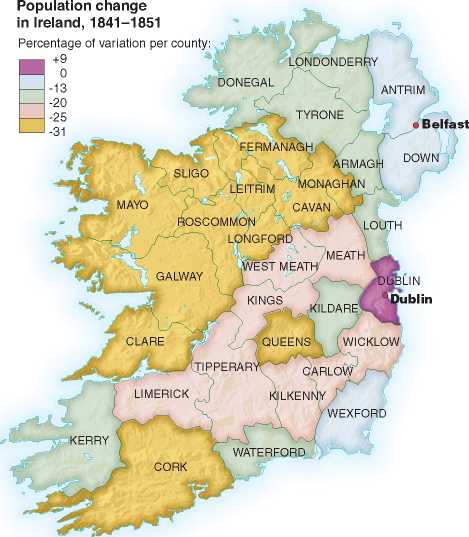Rapid industrialization influenced American life in countless ways, none more significant than its effect on the character of the workforce and consequently on the structure of society. The jobs created by industrial expansion attracted European immigrants by the tens of thousands. It is a truism that America is a nation of immigrants—recall that even the ancestors of the

This fisherwoman from Kerry, one of the poorest counties in Ireland, may have been one of the many too poor to pay for passage to the United States. Tens of thousands starved.


The Potato Famine and Irish Emigration During the potato famine from 1845 to 1851, about a million Irish died and another million emigrated to the United States. The first map shows that western counties of Ireland were the poorest, with more than half of the residents of Mayo, Galway, Limerick and other counties receiving public relief as paupers. The second map shows that during these years tens of thousands of Irish flooded into Dublin, the largest city in Ireland. The greatest population losses were in the poor western regions of Ireland.
Indians came to the New World from Asia. But only with the development of nationalism, that is, with the establishment of the independent United States, did the word immigrant, meaning a foreign-born resident, come into existence.
The “native” population (native in this case meaning those whose ancestors had come from Europe rather than native Americans, the Indians) tended to look down on immigrants, and many of the immigrants, in turn, developed prejudices of their own. The Irish, for example, disliked blacks, with whom they often competed for work. Antiblack prejudice was less noticeable among other immigrant groups but by no means absent; most immigrants adopted the views of the local majority, which was often unfriendly to African Americans.
Social and racial rivalries aside, the infusion of unskilled immigrants into the factories of New England speeded the disintegration of the system of hiring young farm women. Already competition and technical advances in the textile industry were increasing the pace of the machines and reducing the number of skilled workers needed to run them. Fewer young farm women were willing to work under these conditions. Recent immigrants, who required less “coddling” and who seemed to provide the mills with a “permanent” working force, replaced the women in large numbers. By 1860 Irish immigrants alone made up more than 50 percent of the labor force in the New England mills.




 World History
World History









